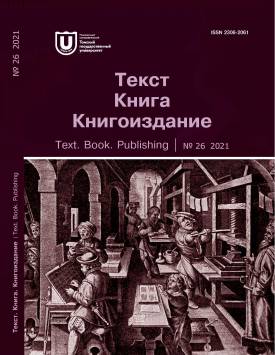German Incunabula Herbals from the Russian State Library: T owards Popular Literature
Early printed herbals have a special place in the 15th-century book production as they were popular both with academics, including medical scientists and pharmacists, and with the common reader. The popular response to the mass production of herbal books made possible by the invention of printing left textual and linguistic evidence in the form of handwritten marginal notes. In the present study, six copies of illustrated herbals printed in Mainz by Peter Schoeffer in 1484 and 1485 are compared as to the subject, language and function of the marginal notes found in them. Five of these books are from the Rare Books Department of the Russian State (former Lenin) Library, the sixth copy from the Moscow University Library is used to enable better comparison. The analysis has shown that the types of marginal notes vary significantly depending on the owners’ social status, interest, background, and on the time and region. Marginal notes in Latin or Greek are considered from the point of view of their thematic (content) and chronological (dating) characteristics. As the result of many centuries of natural science, herbals were an important source of professional knowledge for academics, including medical scientists and pharmacists, of the time. Thematically, linguistically and paleographically, marginal notes of this type can be ascribed to professionals or students of natural sciences. Notes made considerably later than the incunabula era can in fact only be explained by an academic interest on the part of the reader (some notes date after 1700). Marginal notes made in German and, judging by the handwriting, dating closer to 1500 reflect work of common medical practitioners or even of lay readers, who used their herbals to cope with practical problems of their everyday life. These German marginal notes are of high interest as a source for German language history, as they contain synonymous names of plants, additional to those used in the printed text. The analysis of their form, dialect, and distribution proves that they offer valuable lexical material (regional names) in the semantic field usually scarcely documented in medieval literary texts. Those descriptions, which are indicative of region or dialect, show a distinct Southern German origin of their authors.
Keywords
Peter Schoffer’s incunabula,
German illustrated herbals,
marginal notes,
names of plants,
German language history,
dialects,
popular literatureAuthors
| Squires Catherine R. | Russian State Library; Moscow State University | skvayrs@gmail.com |
Всего: 1
References
Squires C. Konstantes und Variables im Aufbau von deutschen mittelalterlichen heilkundlichen Texten und angrenzenden Textsorten // Historische Textgrammatik und Historische Syntax des Deutschen. Traditionen, Innovationen, Perspektiven. Berlin ; New York : De Gruyter, 2010. Bd. 1: Diachronie, Althochdeutsch, Mittelhochdeutsch / A. Ziegler, Ch. Braun (Hrsg.). S. 561-588.
Морозова П.В. Язык и жанр немецких медицинских рукописей XIV-XV вв. : автореферат дис. … канд. филол. наук. М., 2004. 24 с.
Морозова П.В. Популяризация научных знаний в Германии позднего Средневековья: медицинские компиляции // Немецкие средневековые рукописи и старопечатные фрагменты в «Коллекции документов Густава Шмидта» из собрания Научной библиотеки Московского университета / cост. Е.Р. Сквайрс, Н.А. Ганина. М. : МГУ, 2008. C. 364-379.
Дубинин С.И. Немецкий литературный язык позднего средневековья (юго-западный ареал). Самара : Самарский университет, 2000. 199 c.
Филичева Н.И. История немецкого языка. М. : Академия, 2003. 304 с.
Schirokauer A. Germanistische Studien. Hamburg : Hauswedell, 1957. 451 S.
Немировский Е.Л. Возникновение книгопечатания в Москве. М. : Книга, 1964. 404 с.
Keil G. Gart der Gesundheit’ // Die deutsche Literatur des Mittelalters. Verfasserlexikon, 2. Aufl. Berlin ; New York : 1980. Bd. 2. Sp. 1072-1092.
Fischer H. Mittelalterliche Pflanzenkunde. Hildesheim ; Zrich ; New York : Georg Olms Verlag, 1929. 329 S.
PharmaWiki. Medikamente und Gesundheit URL: https://www.pharmawiki.ch/wiki/index.php?wiki=Febrifuga (Datum des Zugangs: 19.12.2020).
Boerhaave H. Aphorismi de cognoscendis et curandis morbis, et materies medica ejusdem suis locis interposita: Prolegomena, chirurgia, febris. Villalpandea, 1798. Pars I. 570 S.
Kerner A. Flora der Bauerngärten in Deutschland // Verhandlungen der Zoologisch-Botanischen Gesellschaft in Wien. Wien : Hrsg. Zoologisch-Botanische Gesellschaft in Wien,: 1855. Bd. 5. S. 787-826.
Zarnke Fr. Nomina lignorum avium piscium herbarium mit deutschen Glossen aus der Frankfurter Hs. // Zeitschrift für deutsches Alterthum. 1853. № 9. S. 388-400.
Köbler G. Altsächsisches Wörterbuch. 5. Aufl. 2014. URL: http://www.koeblergerhard.de/aswbhinw.html (Datum des Zugangs: 20.12.2020).
Benecke G.F. Mittelhochdeutsches Wörterbuch : Mit Benutzung des Nachlasses von Georg Friedrich Benecke ausgearbeitet von Wilhelm Müller und Friedrich Zarncke. 3 Bde. Leipzig, 1854-1866.
Lexer M. Mittelhochdeutsches Handwörterbuch. 3 Bde. Leipzig, 1872-1878.
Köbler G. Mittelniederdeutsches Wörterbuch. 3. Aufl. 2014. URL: https://www.koeblergerhard.de/mndwbhin.html (Datum des Zugangs: 20.12.2020).
Frühneuhochdeutsches Wörterbuch. URL: https://fwb-online.de/lemma/katzen kerbel.s.0m (Datum des Zugangs: 20.12.2020).
DWB = Deutsches Wörterbuch von Jacob und Wilhelm Grimm. URL: http://woerterbuchnetz.de/cgi-bin/WBNetz/wbgui_py?sigle=DWB&mode=Vernetzung& lemid=GT02453#XGT02453 (Datum des Zugangs: 20.12.2020).
Woerterbuchnetz.de URL: http://woerterbuchnetz.de/cgi-bin/WBNetz/wbgui_py? mode=Vernetzung&hitlist=&patternlist=&lemid=FK01004&sigle=FindeB (Datum des Zugangs: 20.12.2020).
Anton Trutmanns ‘Arzneibuch’ / Hrsg. G. Keil. Würzburg 1992. Teil II: Wörterbuch. 1121 S.
Seuter M. Hippiatria, ein vast schönes und nutzliches Buech von der Roßartzney. Augsburg : Johann Schultes, 1599. 440 S.
Zedler J.H. Grosses vollständiges Universal-Lexicon aller Wissenschaften und Künste. 1731. Bd. 4; 1754. Bd. 62. URL: https://www.zedler-lexikon.de/index.html? c=blaettern&zedlerseite=ze040866&bandnummer=04&view=100&seitenzahl=0866&dateiformat=1&view=150&supplement=0%27 (Datum des Zugangs: 20.12.2020).
Дзюба Е.В. Лингвокогнитивная категоризация в русском языковом сознании. Екатеринбург : Урал. гос. пед. ун-т, 2015. 285 c.

